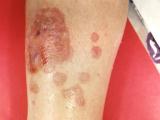Jul 3, 2012
Mexican H7N3 poultry outbreaks trigger animal health emergency
Mexico's government declared a national animal health emergency yesterday, designed to trigger more intensified efforts to contain a highly pathogenic H7N3 outbreak that has infected almost 1.7 million poultry, according to Agence France-Presse (AFP) today. The emergency declaration expands efforts to control the disease beyond the outbreak area to include the whole country and sets forth plans for quarantine, slaughter, vaccination, and culling of infected birds. The agriculture ministry said in a statement that poultry farming makes up 40% of the country's livestock production and that economic loss from the outbreaks "is and will be irreparable," according to the report. The ministry said about half of the infected birds have died or been culled. The outbreak began on Jun 13 on commercial farms in Jalisco state and is Mexico's first highly pathogenic avian influenza event since the mid 1990s, when farms battled the H5N2 virus. H7N3 rarely infects humans but has been known to cause mild flulike symptoms and conjunctivitis.
Jun 26 CIDRAP News story "Tests reveal high-path H7N3 in Mexican poultry farm outbreaks"
J&J seeks US approval for MDR-TB drug
Johnson & Johnson (J&J) said it is seeking US Food and Drug Administration (FDA) approval for its new drug, bedaquiline, for treating multi-drug-resistant tuberculosis (MDR-TB), the Associated Press (AP) reported yesterday. It would be the first new TB drug in more than 40 years, the story said. The drug has been tested in several hundred MDR-TB patients in studies lasting 6 months to a year and a half. J&J will begin late-stage testing of bedaquiline in 600 patients over 9 months this fall in trials designed to determine if it can reduce treatment time from the current 18 to 24 months to 9. TB is not common in the United States (11,182 cases in 2010, according to data from the Centers for Disease Control and Prevention [CDC]), but 8.8 million cases were reported worldwide in 2010, according to the World Health Organization, killing 1.4 million. Among infectious diseases, only HIV/AIDS kills more people globally. Dr Wim Pays, head of J&J's infectious diseases research division, said the company also will apply for drug approval in nations in which TB is common.
Multistate Salmonella outbreaks linked to turtles grow to 149 cases
The recent burden of Salmonella illnesses linked to small turtles has grown to six outbreaks involving 149 cases in 28 states, the CDC reported Jun 29. The numbers represent 25 new cases, 1 new state (Tennessee), and 1 new outbreak since the last CDC update on May 10. The outbreak strains (Salmonella Sandiego, Pomona, and Poona) have not changed, and 28 people (up from 19) have been hospitalized, but none have died, the agency said. Of the patients, 72% reported exposure to turtles, 64% are 10 years old or younger, and 28% are 1 year old or younger. Affected states and case numbers are: Alabama (2), Alaska (2), Arizona (5), California (26), Colorado (5), Delaware (3), Georgia (3), Illinois (1), Indiana (1), Kentucky (1), Massachusetts (3), Maryland (6), Michigan (2), Minnesota (1), New Jersey (7), New Mexico (4), New York (25), Nevada (6), North Carolina (1), Ohio (2), Oregon (1), Pennsylvania (14), South Carolina (4), Tennessee (2), Texas (17), Vermont (1), Virginia (3), and West Virginia (1). Because of the risk of salmonellosis, the FDA since 1975 has banned the sale of turtles with 4-inch shells or smaller.
Jun 29 CDC update
USDA unveils plan to improve chemical residue testing
The US Department of Agriculture (USDA) yesterday announced new steps to protect the public from chemical residues in meat, poultry, and egg products, according to a press release from agency's Food Safety and Inspection Service (FSIS). One program will allow testing for several types of legal and illegal drugs, such as antibiotics, anti-inflammatories, and growth promoters. In the past, the FSIS could test one sample for one chemical at a time, but the new system allows one sample to be simultaneously tested for as many as 55 pesticide chemicals, 9 antibiotics, various metals, and eventually more than 50 other chemicals, according to the statement. The FSIS also said it is expanding its sampling program, boosting the number of samples from each slaughter class from 300 to 800. If illegal residues are detected at a facility, the FSIS said it will notify the FDA, which may review the practices of producers supplying the establishment with livestock or poultry and spur increased testing and review. The methods are part of the USDA's National Residue Program, an intradepartmental collaboration of testing products produced in or imported into the United States. The USDA said it will post the announcement in the Federal Register on Jul 6 and is asking the public to comment on the plan, which is slated to take effect 30 days later.
Jul 2 FSIS news release






















